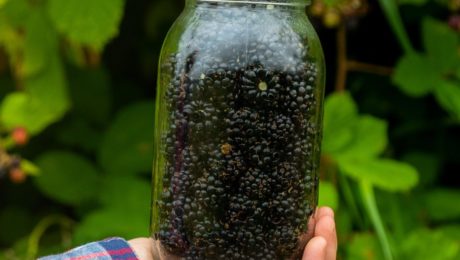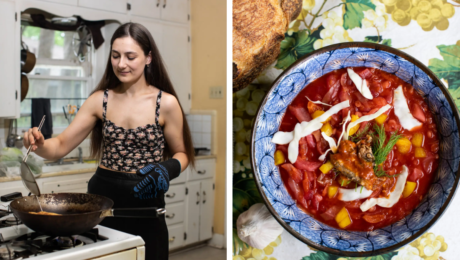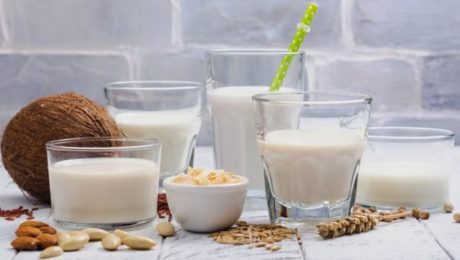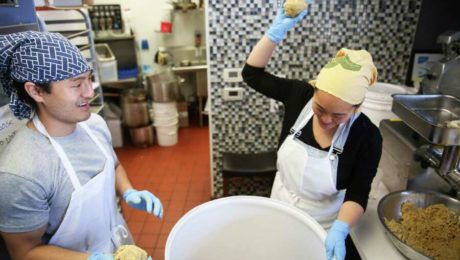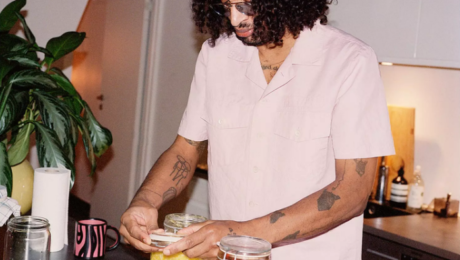Fermented Blackberry’s Anti-Wrinkle Power
A new study found ingesting fermented blackberries wards off wrinkles, increasing collagen and skin thickness.
Researchers tested the effects on Korean adults – between the ages of 35 and 60 – over a period of 12 weeks . The blackberries – fermented with lactic acid bacteria – were found to significantly decrease wrinkles around the eyes.
The results, published in the journal Cosmetics, are a follow-up to a clinical trial on the formula (known as BB-1000) in mice.
“The significance of this study is that the anti-wrinkle efficacy of a fermented blackberry product was confirmed not only in previous animal experiments but also in this clinical trial.” As a result of clinical trials on skin wrinkle improvement and safety, BB-1000 is expected to be used with confidence as a healthy functional food that can improve skin wrinkles.”
Read more (Molecules)
- Published in Science
Saving Ukrainian Food Culture
When the war in Ukraine broke out, Olga Koutseridi, a Ukrainian American baker, writer and historian, felt an urgent need to preserve the traditional Ukrainian recipes she grew up with.
Koutseridi’s ancestors tended gardens outside Mariupol. They preserved the food they couldn’t eat, fermenting tomatoes, cucumbers, cabbage and sour cherries. They drank homemade kombucha, kefir and vodka. They made varenyky (dumplings stuffed with sour cherries and cheese) and chebureki (fried pastry filled with meat).
“Maybe now is not the time to celebrate Ukrainian food,” Koutseridi said. “But this feels like the only chance we have to preserve it. … Every time someone makes a Ukrainian dish in an American kitchen, it’s an act of resistance.”
Koutseridi has begun compiling these recipes, with an emphasis on history. She’s contacted Ukrainian food experts around the world (including Olia Hercules, author of Summer Kitchens).
She feels that war is destroying Ukraine’s identity, history and culture.“Now is the time to delve into{the country’s] food in detail,” Hercules said. “There’s so much more to it than borsch.”
Read more (The New York Times)
- Published in Food & Flavor
Mead’s Modern Moment
“Somewhere between wine, beer, and cider lives mead. An ancient libation like no other, mead has been a pleasant surprise to drinkers for eons. Norsemen would be thrilled to know that it has made a modern-day comeback.”
Mead was highlighted in an article in Tasting Table, “appreciated by everyone from Vikings to millennials.” Also known as honey wine, it is experiencing a modern resurgence. Mead makers are adding unique seasonings and spices to enliven their creations – but it needs to be at least 51% wine.
More meaderies are popping up – there is now at least one in every U.S. state. But liquor stores are still confused on where to put meads. The national sales manager of Chaucer’s Cellars – the country’s longest-running meadery – says most stores have no clue where to display mead.
Read more (Tasting Table)
- Published in Business, Food & Flavor
Chef’s Secret: Fermented Bean Curd
Chef Andrew Wong created the first Michelin two-star Chinese restaurant outside Asia. His London-based A Wong is an homage to China’s 3,000-year culinary history and a contemporary spin on the country’s regional cuisine.
Fermented wild sea bass and fermented coconut are part of the “Taste of China” dinner menu. A popular dish called “Why the Buddha Didn’t Jump Over the Wall” is barbecued sweet potato covered in a fermented, salted black-bean relish. It’s no surprise Wong’s favorite ingredient is fermented bean curd. He says the tofu, soaked in salt and chili, is as close to cheese as you can get in China. It’s eaten with congee and used as a condiment.
“It’s very salty; umami in its purest form,” Wong says. “I use it a lot in my cooking, especially in vegetarian dishes where we can’t use oyster sauce. We cook it out with some stock, ginger, garlic, and make a sauce. The combination of vegetables, garlic, chili and fermented bean curd creates a really deep meaty flavor.”
He advises chefs to use it like a stock cube, because it’s soft and will coat the mouth in umami flavor.
Read more (Guardian)
- Published in Food & Flavor
Turning Brewery Waste Into Milk
Brewing giants Molson Coors and Anheuser-Busch are introducing new brands into the growing alternative milk category.. The brewers’ non-alcoholic, plant-based barley milks are “pioneers of a nascent sub-category in the fast-growing alternative milk field, with each product utilizing byproducts of their main business,” according to Ad Age.
Barley milk, notes the article, is a smart product that helps the brewers diversify their product portfolios. buoys declining beer sales, capitalizes on the growing wellness trend and upcycles a brewing byproduct.
Both brands (Molson Coors calls their barley milk Golden Wing; Anheuser-Busch, Take Two) are in the trial stage and aiming to raise awareness. Golden Wing is currently sold only in Southern California, and Take Two is only in the Pacific Northwest.
Take Two is positioned as an eco-friendly beverage, and is working with advocacy groups like the Upcycled Food Association. Anheuser-Busch produces about 8 billion pounds of spent barley a year.
“All that’s been removed is the sugar and starch. All this wonderful protein and fiber is still there,” says Holly Feather, head of marketing for Anheuser-Busch. She notes much of that spent grain is sent to commercial farms. “Saving the planet doesn’t have to be so serious. You can have a good time and do something good in the mix.”
Golden Milk, on the other hand, is aiming to be the “badass” alt milk alternative, and is marketing to health-conscious men.
“We want to invoke curiosity in consumers when they see our packaging and our bold voice, and ultimately get them to try our great-tasting products,” says Brian Schmidt, marketing manager for Molson Coors. “Longer-term, we want Golden Wing to unlock barley milk as the next big thing in the plant-based milk category, and we believe it can do just that.”
Read more (Ad Age)
- Published in Business
Scaling Artisanal Fermentation
Fungi fermenter Shared Cultures was the featured cover story in a recent Food & Wine section of the San Francisco Chronicle. Company co-owners Elena Hsu and Kevin Gondo make small-batch fermented soy sauce, miso, and sauces and marinades using koji and wild, foraged mushrooms.
The article calls Shared Cultures “the darling of the Bay Area food scene.” It details how they use traditional techniques with unexpected ingredients, like a shoyu with quinoa and lentils, a miso with cacao nib and a koji salt with leek flowers.
Hsu and Gondo also open up about the challenges of scaling artisanal fermentation. They are the only employees at the companys and can’t keep up with the demand. Their ferments require a lot of time, some fermenting for eight months in a closet-size room in their rented commercial kitchen. They note that it is too expensive to rent or purchase their own warehouse in the Bay Area.
Multiple California chefs use Shared Cultures products for an added umami punch. Hsu encourages home cooks to experiment with their products, too, “You don’t have to have a $300 tasting menu to try these flavors,” she says. “You can be the chef.”
Read more (San Francisco Chronicle)
- Published in Business, Food & Flavor
LAB Makes Sour Cream Healthier
Adding fermented pickles to sour cream increases the health benefits of the cream, lowering cholesterol and increasing antioxidant properties, according to new research.
Scientists from the Poznań University of Life Sciences in Poland based their research on the French paradox, “the observation that… reduced heart disease is associated with a diet high in saturated fat and cholesterol.” They picked sour cream because of its high levels of saturated fat and cholesterol.
“The results also show that the health-promoting potential of sour cream is enhanced by the presence of metabolically active LAB,” continues the study, published in the Journal of Dairy Science.
The scientists note future work will revolve around characterizing the properties of specific lactic acid bacteria produced by spontaneous fermentation.
Read more (Medical and Life Sciences)
Zilber: Fermentation’s Endless Potential
David Zilber says the potential for fermented food is endless. “There isn’t any sort of food that doesn’t benefit from some aspect of fermentation,” he said. “There’s really no limitation to its application.”
Zilber, the former head of the Noma fermentation lab, co-authored “The Noma Guide to Fermentation” with Noma founder Rene Redzepi. In the fall of 2020, Zilber surprised the food world when he left his job at Noma to join Chr. Hansen, a global supplier of bioscience ingredients.
He shared his insight on fermentation on The Food Institute Podcast. An Oxford study found over 30% of the world’s food has been touched by microbes. Zilber, a microbe champion, says one of the best parts of fermenting with plant-based ingredients is the microbes don’t need to change.
“We do need to find ways to adapt them to new sources, but there will always be a place within the pie chart of what humans are eating on earth for fermentation,” he says.
Part of Zilber’s work at Chr. Hansen is in the plant-based protein alternative segment, fermenting plant ingredients to “bring this other set of characteristics” to a new food item. He advises fermenters using plant-based ingredients to make their ingredient list concise and pronounceable to consumers.
“I am a huge proponent for formulating recipes from whole ingredients,” Zilber says. “Keeping the ingredient list short and concise and using natural processes to achieve flavor or textual properties … because it is the healthiest way to eat.”
Across the spectrum of fermentation, he feels fermented beverages is the category where he sees the greatest opportunity.
Read more (The Food Institute)
- Published in Food & Flavor
AI-Generated Wine Reviews?
New artificial intelligence software writes wine and beer reviews said to be indistinguishable from those by human critics. Researchers hope this tool will help wine and beer producers aggregate more reviews, and also provide human reviewers with a template. But the software has a major limitation: it cannot accurately predict the flavor profile of a beverage, something that can only be sampled and described by human taste buds.
Keith Carlson of Dartmouth College, who co-developed the algorithm, said wine and beer are perfect for AI-generated text because of the variety of their descriptors. Fermentation style, growing region, grape or wheat variety and year of production are all mentioned in reviews, aiding the AI algorithm. Reviews also tend to use the same vocabulary — words like “oaky,” “floral” and “dry.”
“People talk about wine in the same way, using the same set of words,” Carlson said, adding “it was just a very unique data set.”
The research team — interdisciplinary scientists from Dartmouth, Indiana University and The Santa Fe Institute — used more than a decade’s worth of reviews (over 125,000) from Wine Enthusiast, and 143,000 beer reviews from the website RateBeer. Results were published in the International Journal of Research in Marketing.
Next, they envision using the software for other experiential products, such as coffee or cars.
Read more (Scientific American)
- Published in Business
Alt Protein Hype Missing Bigger Food Industry Solution
Will alternative proteins save the planet? A report by the International Panel of Experts on Sustainable Food Systems (IPES-Food) says alt proteins – or what they call “lab meat” – aren’t the answer. In a new report, these experts say major reforms need to be put in place to increase biodiversity of food, improve access to better nutrition and limit Big Food’s control over the food system.
Companies, governments and investors are turning to alternative proteins as a way to feed a rapidly growing population but, the panel notes, they don’t address the world hunger crisis.
“In reality they lead us back to the same problems of our industrial food system: giant agribusiness firms, standardized diets and industrial supply chains that harm people and the planet,” announces a video created by IPES-Food. “We need to change the system, not the product.”
Adds Phil Howard, lead author of the report: “It’s easy to see why people would be drawn to the marketing and hype, but meat techno-fixes will not save the planet. In many cases, they will make the problems with our industrial food system worse — fossil fuel dependence, industrial monocultures, pollution, poor work conditions, unhealthy diets, and control by massive corporations. Just as electric cars are not a silver bullet to fix climate change, these solutions are not going to fix our damaging industrial food system..”
The report suggests that, to feed a growing population, the food industry should focus on sustainable food systems, not a transition to alternative proteins. A healthy food system should be regional, nutritious and focused on how real food is produced.
Read more (IPES-FOOD)
- Published in Business

